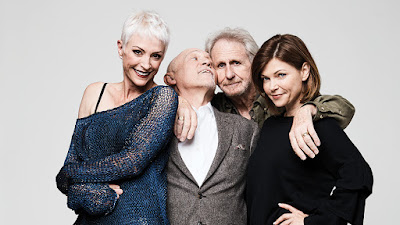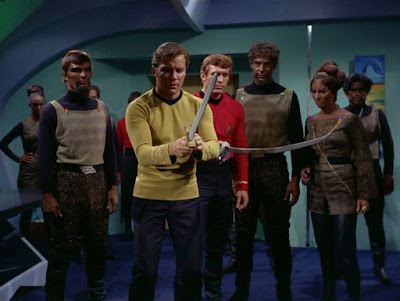Within the space of a few weeks, the truth of mortality has hit the Trek family quite hard. On November 21 we lost Michael J. Pollard, who guest starred in the Original Series episode "Miri". Then, on December 2, legendary Trek writer and story-teller Dorothy Fontana (usually known as D.C. Fontana) passed away. December 5 saw the passing of Robert Walker, best known as Charlie X. On December 8, we were hit with a double-whammy. Michael Lamper, husband of TNG star Marina Sirtis passed away the night before. Finally, our beloved Changeling and Constable Odo was lost as Rene Auberjonois lost his battle with lung cancer. As I did a few months ago when we lost three members of the Trek family in one day, I will pay a small tribute to each of those who we have recently lost, but focus on the one who I had the most interactions with. I mourn the loss of all, so this is not meant to lessen or disrespect any. I just have more of a connection with one than the others.
Dorothy Catherine Fontana brought us many classic tales in Star Trek. Among them were "Charlie X", "Journey to Babel", "Encounter at Farpoint", "Dax", and my favorite episode of the animated series, "Yesteryear". Having to hide the fact that she was a woman, she often used either abbreviations of her name (D.C.) or a pseudonym. She had a way of understanding the characters, and while some of her work was edited to the point where she was unhappy, she often took the high road and did not try to be overly critical of others. In the DS9 episode "Far Beyond the Stars" the character of Kay Eaton was created as an homage to Dorothy. In addition to Star Trek, Fontana had written for several television shows, including Babylon 5, the 6 Million Dollar Man, and Earth: Final Conflict. She passed away at the age of 80.
Michael J. Pollard also passed away at the age of 80. He is best known to Trek fans as Jahn, leader of a group of feral children known as the Onlies. He brought a sense of innocence savaged by loss to his character. Pollard had several credits to his acting resume, including an episode of "Lost in Space", as well as roles in films such as "Roxanne", "Scrooged", and "Bonnie and Clyde", for which he earned two Golden Globe nominations and an Oscar nomination.
Robert Walker Jr. passed away on December 5 at the age of 79. He was born into a family of actors and received a Golden Globe Award in 1963. In Star Trek, he played the troubled young Charlie Evans in the first season episode "Charlie X". Robert, though older than Charlie was supposed to be, found a way to walk a fine balance between youthful innocence and darkness. He brought an intensity to the role that was captivating. He also guest-starred on many notable television series, including "Bonanza", "Murder, She Wrote", "The Six Million Dollar Man", and "Dallas".
Michael Lamper was an accomplished rock musician. He had played with a number of groups and artists, including Quiet Riot and the Allman Brothers. He was a background actor for Star Trek, appearing as an Acamarian gatherer in the 3rd season TNG episode "The Vengence Factor". Most notably, he is remembered for being the husband of Marina Sirtis, TNG's Deanna Troi. In the world of Hollywood where marriage is seen as an often fleeting thing, he and Marina were married for 27 years. I had the chance to meet Marina on a couple occasions, and when asked about her husband, she spoke warmly and affectionately of him. My heart goes out to her on her loss. Michael was 64 years old.
Finally, I am deeply saddened by the passing of Rene Auberjonois at the age of 79 on December 8. He played Ezral on an episode of Enterprise, Colonel West on Star Trek VI, but most importantly he was Odo on all seven seasons of Deep Space Nine. In addition to his roles in Trek, he had starred in the 1970 movie MASH, where he originated the role of Father Mulcahy. Aside from a lengthy list of television and film credits, Rene was a regular on the 80s sitcom "Benson", with Voyager regular Ethan Phillips, and the legal drama "Boston Legal", alongside William Shatner. He was also an accomplished voice actor. My favorite of his was in Disney's "The Little Mermaid" as Chef Louis, the nemesis of Sebastian the crab. He was also one of the many main cast members in Star Trek to direct episodes. He directed eight episodes for DS9, including "Waltz", "Prophet Motive", and "Ferengi Love Songs". Rene leaves behind a wife of over 50 years and two children.
The character of Odo truly showcased Rene's talents as an actor. He was able to emote so much through the several layers of latex. He brought warmth and depth to a character that could have easily become two-dimensional. He brought forth emotions that ranged from rage to surliness, from compassion to tenderness. He also brought out the best in costars. In the last few days, many of them have shared how gracious of an actor he was, and how he motivated them to always bring their best efforts to their own performances.
A year after that, Rene was appearing at a local convention, and we had to go. I had already had an autographed picture of Odo, so we had him sign a picture of Chef Louis for my then two year old daughter. She was so excited to meet a Disney character that she wanted to be ready, so we dressed her in a "Little Mermaid" T-shirt and she brought along her stuffed toy of Sebastian the crab, the chef's nemesis from the film. When Rene saw her, he beamed and went totally into character, claiming how beautiful my daughter looked and how excited he was to see "ze crab" again. He then launched into a rendition of "Les Poissons" just for her. My daughter could not stop smiling the biggest smile I had ever seen. That picture still hangs in her bedroom. A few years later I was at the Las Vegas convention and stopped by his autograph table where he was happily chatting with anyone who wanted to chat. We struck up a conversation and I mentioned the role that we shared. He was so gracious towards me when I thanked him for giving one of my favorite Disney characters a voice.
In spite of his accomplishments as an actor, that is what I will remember him for the most. He was an excellent actor, but he was more importantly an excellent person. He was kind, patient, giving, and cheerful. He often sponsored a variety of charities. At the 2016 Vegas convention I last saw him at, he was selling memorabilia to support Doctors Without Borders, a charity that he felt connected to through his role in "MASH". He was always ready to laugh and joke with whoever he was around. I saw his performances shine, no matter how bad or great the show or movie was. He was a consummate professional and he knew how to treat the people around him.
May you find peace in the Great Link, good sir. We are better for having known you, and your contribution to the world was a great and worthy one.


























































